A Framework to Kickstart Your B2B Content Strategy
 B2B content strategy - like all content strategy - is the process of translating your business objectives and goals into a plan that uses content as a primary means of achieving those goals.
Content strategy that is disconnected from business goals is just content. You put it out there, and maybe it gets results or maybe it doesn’t. Before a content strategy can be created in even its most basic form, you need to have a firm understanding of your business goals and customers.
It’s easy to slip into thinking that “content strategy” is synonymous with “SEO content” or social media content. Those are certainly channels you might focus on with a B2B content strategy, but they’re by no means the only ones.
In this guide, you’ll get a rundown on:
B2B content strategy - like all content strategy - is the process of translating your business objectives and goals into a plan that uses content as a primary means of achieving those goals.
Content strategy that is disconnected from business goals is just content. You put it out there, and maybe it gets results or maybe it doesn’t. Before a content strategy can be created in even its most basic form, you need to have a firm understanding of your business goals and customers.
It’s easy to slip into thinking that “content strategy” is synonymous with “SEO content” or social media content. Those are certainly channels you might focus on with a B2B content strategy, but they’re by no means the only ones.
In this guide, you’ll get a rundown on:
- What kinds of goals a good B2B content strategy can accomplish
- How your business model will affect your content strategy
- Types of B2B content
- How to build your own B2B content process
A Framework to Kickstart Your B2B Content Strategy via @CoSchedule
Click To TweetClaim Your Content Plan Template
Before you learn about how to optimize your B2B content strategy, make sure you claim this complimentary content plan template to ensure you have all the materials you'll need to make the most of the knowledge you find here. Got it? Let's go.The Goals of B2B Content Strategy
For B2B specifically, your content strategy can address several different goals, such as:- “We need to increase the pipeline with qualified leads.”
- Lead generation assets are essential for collecting emails from qualified and interested prospects. In-depth, high-value content that gives readers something useful can be a great bridge into your actual product.
- “We need to speed up our sales cycle and support our sales team.”
- Sales enablement can help your sales team anticipate common questions and objections. It can educate people throughout your prospect’s organization without requiring every stakeholder to get on a sales call.
- “We need to lower our customer acquisition costs.”
- Content geared toward search engines can be a great way to organically attract people who are specifically interested in solving problems related to your product.
- “We need to decrease the volume of support requests our customer success/support team is getting.”
- Post-purchase content that helps users get onboarded more quickly and adopt your products is a powerful way to lighten the burden on your support teams and increase customer satisfaction.
- What do we want our content to accomplish?
- What KPIs can we set for each type of content we publish?
- How will we tailor each piece of content to a specific persona or potential buyer?
- What does a content audit of our site tell us about our existing content? Can our goal be reached by using what we already have or do we have content gaps?
- How will we source content ideas? How can we ensure our content directly ties back to our business and customers?
- What content formats can we produce at a high level? Is our message best conveyed through video, audio, graphics, or written content?
- How will our documented content strategy be made accessible to all stakeholders?
- How will we distribute each piece of content to maximize its reach and impact?
Why a B2B Content Strategy is Essential
Research from Gartner on modern B2B buying processes shows the importance of giving your buyers information they need to make a good decision. “Customers who perceived the information they received from suppliers to be helpful in advancing across their buying jobs were 2.8 times more likely to experience a high degree of purchase ease, and three times more likely to buy a bigger deal with less regret,” the research showed. The same research showed that in a B2B sale, your sales team will get roughly five percent of all the time the buyer spends on the purchasing process. The rest of the time will be spent independently vetting your solution and weighing it against other options. How do you make that work to your advantage? Content. Content that proves your value, answers key questions, positions your products, and overcomes objections. Arming your buyers with information that helps them make a good decision and sell your solution internally can give you a voice in buying decisions even if your sales reps aren’t actively engaging.Types of B2B Content Strategy
Before you can build a B2B content strategy, you have to think about your business model and how that will impact what sort of content will be most effective for you. There are two broad types of B2B business models - sales-led and product-led.Sales-Led Content Strategy
Sales-led B2B companies will rely more on sales teams to sell into customer organizations. These products tend to be more complex, expensive, and have long sales cycles that include multiple decision-makers. This is common in industries like healthcare, energy/utilities, and financial services, but even some SaaS companies like Salesforce and Gainsight fit in here.Product-Led Content Strategy
Product-led B2B companies use their product itself to drive acquisition, retention, and account expansion. Many SaaS companies today are adopting this model. Here, content and SEO, among other channels, drive users to a trial or freemium experience where they can try the product before buying. The products in this model are usually inexpensive, lowering the friction in the user’s decision-making process if they find value in the trial experience. Companies like Smartsheet, Notion, and Coda are all great examples here. They sell directly to end users. The solution generally benefits users more when other people within the same organization are also using the solution. Once there’s a critical mass of people in an organization using the same product, it’s a much easier buying decision for budget-holding stakeholders. Of course, some companies have elements of both models. At MarketMuse, we have a sales-led channel and a product-led channel that allows us to serve different types of customers. Our content strategy reflects that. We speak to both buyers at large enterprises and end users at smaller companies, agencies, and publishers.How does your business model affect your content strategy?
Where your business falls on the spectrum of sales-led to product-led will influence your approach to content strategy. A sales-led approach will require you to navigate through sometimes complex buying processes on the part of your prospects. Your content will be more focused on buyer enablement - helping your internal champions within your prospect organizations sell your solution with you. Thus, your content won’t really be focused on the eventual end users of the products. They likely don’t have buying power. Instead, you’ll be creating content to prove your business value, show how your product will be implemented, and answer questions from stakeholders outside of your target business unit. A product-led model means you’ll be trying to reach potential end users of the product. Product-led growth means getting people using your solution as frictionlessly as possible, whether it’s with a freemium model or a free trial. Content for this model should help users solve problems, understand concepts, and make their jobs easier. It should lead them seamlessly into trying your product out for themselves.The Most Effective Types of B2B Content Across Buyer’s Journey
In this section, we’ll walk through some of the most effective types of B2B content. This framework for B2B content types was first laid out by John-Henry Scherck, founder of Growth Plays. We’ll dive deep into the framework, using examples from different industries and expanding on some of the ideas. We’ll focus more on searchable, openly accessible content here rather than content like whitepapers, eBooks, webinars, etc. All of those are important and useful in their own way, but without a strong foundation of easily discoverable content on your domain, it’ll be hard to get a lot of use out of your gated assets. Moreover, those assets should be closely related from a topic perspective to the content you’ve published on your site. There’s no point in creating an in-depth asset on a topic you’ve said nothing about elsewhere.Branded keywords
This is the easiest place to start. Content that targets branded keywords is almost always a winner, even if your domain isn’t very authoritative yet. Google is smart enough to know that if someone is typing a brand name into search, the user is likely best served with content from that brand. You can use keyword tools or Google Autosuggest to find branded keywords people are searching for. For example, we could look in Ahrefs to find keywords that CoSchedule is ranking for: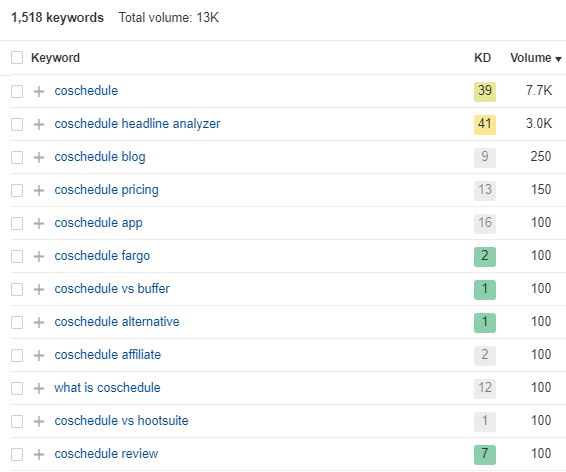 Google Autosuggest gives us some similar data, though at a much smaller scale:
Google Autosuggest gives us some similar data, though at a much smaller scale:
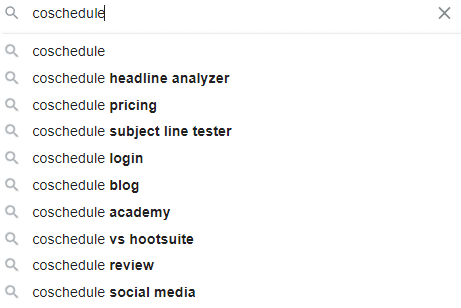 It’s worth noting that if your brand is extremely new and not well-known, you may not find a lot of branded keywords in a keyword tool or even Google Autosuggest.
That doesn’t mean you can’t infer what pages you’ll need to target common branded keywords. One easy way to do this is to pick a more well-known competitor and type their name into Google. Then, see what sorts of keywords the Autosuggest function comes up with.
For example, if you had a CRM solution, you could see what branded keywords companies like HubSpot or PipeDrive rank for.
It’s worth noting that if your brand is extremely new and not well-known, you may not find a lot of branded keywords in a keyword tool or even Google Autosuggest.
That doesn’t mean you can’t infer what pages you’ll need to target common branded keywords. One easy way to do this is to pick a more well-known competitor and type their name into Google. Then, see what sorts of keywords the Autosuggest function comes up with.
For example, if you had a CRM solution, you could see what branded keywords companies like HubSpot or PipeDrive rank for.
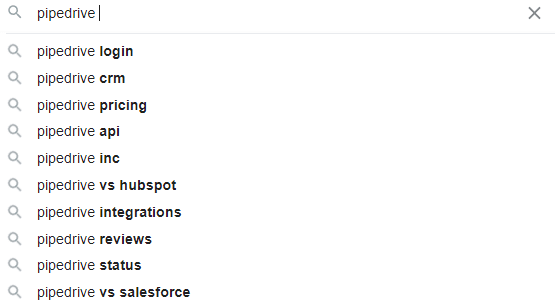 We can see that keywords like “pipedrive login,” “pipedrive pricing,” and “pipedrive integrations/API” are at the top of the list. If we have a competitive product, we would want to have pages on our domain that target those types of keywords for our own brand, since we know it’s what potential customers are looking for when evaluating solutions in our space.
Branded keywords are almost always quick wins. The people searching for them are clearly evaluating your brand. Take advantage of the visibility you can get by creating pages for these branded queries.
We can see that keywords like “pipedrive login,” “pipedrive pricing,” and “pipedrive integrations/API” are at the top of the list. If we have a competitive product, we would want to have pages on our domain that target those types of keywords for our own brand, since we know it’s what potential customers are looking for when evaluating solutions in our space.
Branded keywords are almost always quick wins. The people searching for them are clearly evaluating your brand. Take advantage of the visibility you can get by creating pages for these branded queries.
Alternatives and comparison pages
One of the best ways to position your solution, especially if you’re in a crowded market, is to create content that helps people compare their options. “Alternatives” pages target keywords like “hubspot alternatives” or “notion alternatives.” These pages are a one-to-many comparison of similar solutions in a given vertical. They’re a great way to frame the market. By contrast, “comparison” pages target queries like “Canva vs Photoshop” or “Figma vs Photoshop.” In this case, you’re creating pages that dive deep into a one-to-one comparison between your product and a competitor. The idea isn’t to simply write about why you’re great and your competitors aren’t. Different solutions will be great for different personas. You want to use these pages as an opportunity to really show who your solution is ideal for. One example of alternative/comparison pages done right is from Heap. Here is their alternatives page. Scrolling through it, we can see a lot of great elements that give buyers the information they need to make an informed decision about a product analytics solution.- An easy-to-read table that compares features across the market and shows exactly where Heap is a leader
- Links out to one-to-one comparison pages
- Testimonials that link to case studies
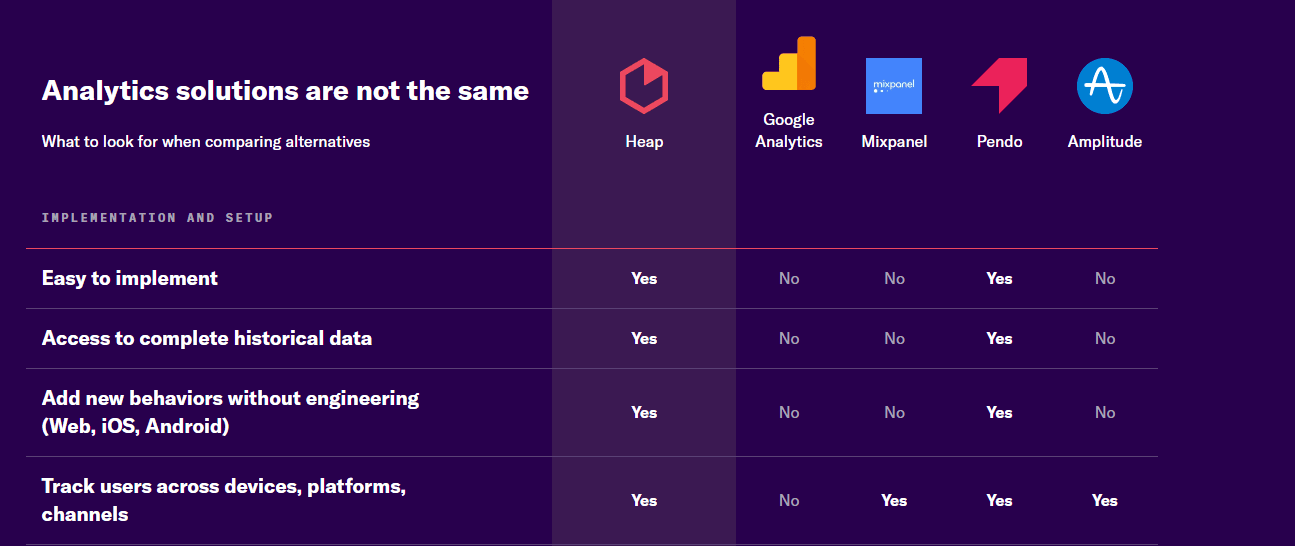 The one-to-one comparison pages have a similar flow. Users who are deciding between Heap and another competitor can easily compare the two options.
The one-to-one comparison pages have a similar flow. Users who are deciding between Heap and another competitor can easily compare the two options.
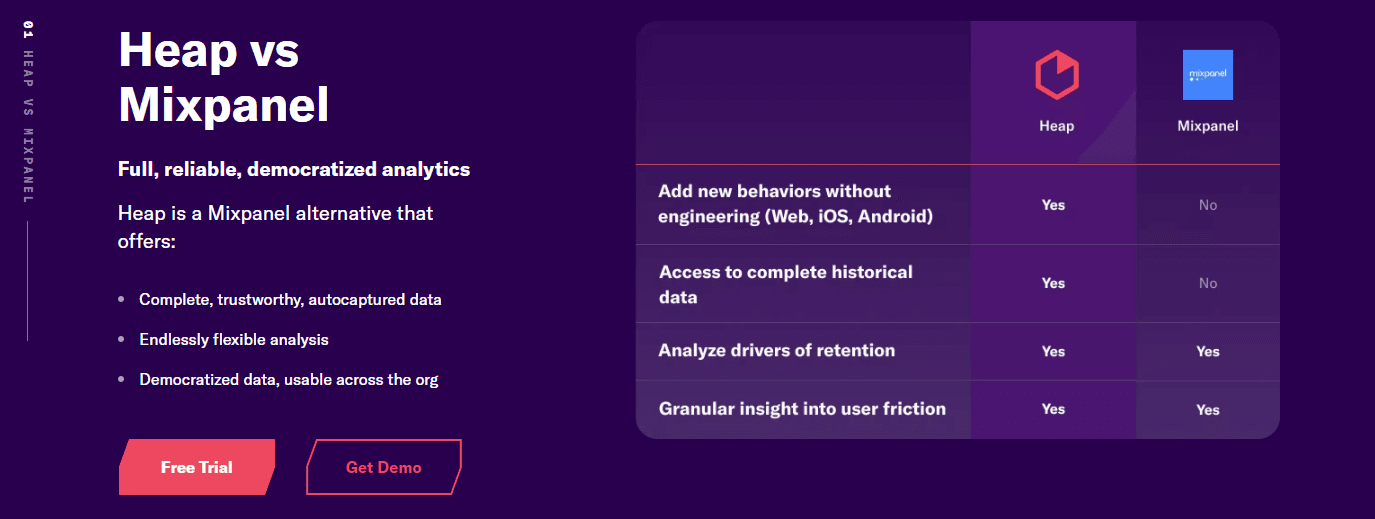 One last thing to note here is that typical keyword tools won’t give you an accurate picture of how well these pages can perform. You may not find keywords like “your solution vs. your competitor,” or they might otherwise have low search volume.
They’re still crucial pieces of content to have. They let you control the conversation and framing of your space, and are powerful for helping potential customers make the right decision.
One last thing to note here is that typical keyword tools won’t give you an accurate picture of how well these pages can perform. You may not find keywords like “your solution vs. your competitor,” or they might otherwise have low search volume.
They’re still crucial pieces of content to have. They let you control the conversation and framing of your space, and are powerful for helping potential customers make the right decision.
Top of Funnel Content - Jobs to be Done, Questions, Pain Points
Question-focused content, as the name suggests, answers key user questions. At its best, it helps users get the basics of a topic down and gives them a clear path to dive deeper on the topic if they choose to. One company that does this well is CallRail, a call tracking software solution. In their article, “What is a Drip Campaign?,” they give the user the answer right up front. People who just want the definition can get what they need and move on. People who want to go further can keep going to learn more about drip campaigns. This is “question” content executed well. Don’t force readers to spend a lot of time getting an answer. Front-load the value and if people want to read more, they will. Ahrefs is one of the most successful B2B brands at creating JTBD content. They know what their audience is looking for - SEO and content workflows and knowledge - and create some of the most comprehensive content on those topics. One of their most recent articles on “blog SEO” is a great example of an article that takes a broad topic, conceptualizes it in an easy-to-understand way, and gives users an actionable way to get started on improving SEO for their own blogs.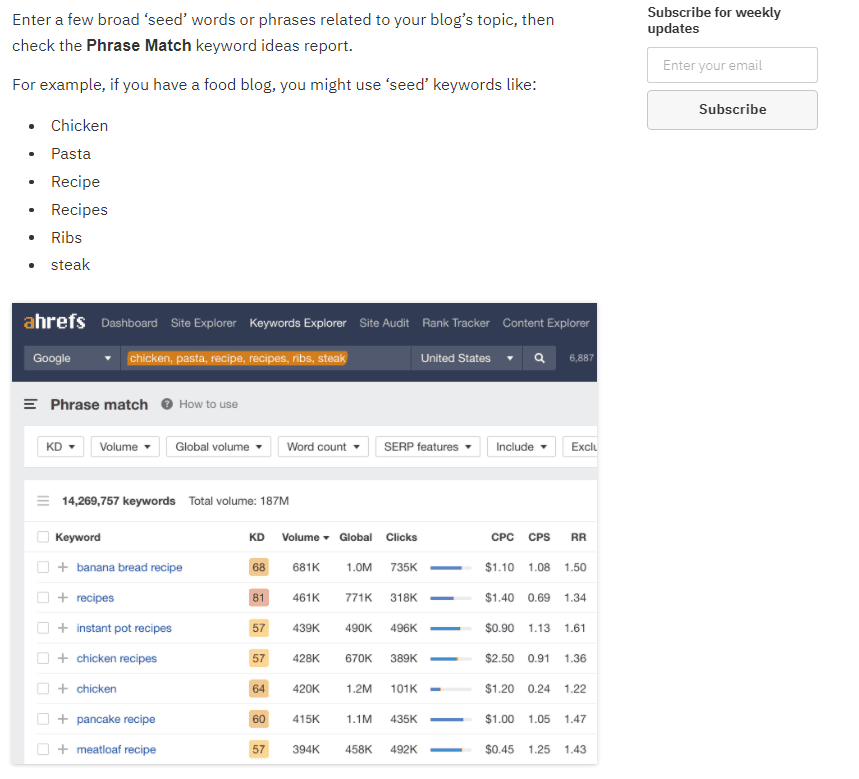 Most importantly, Ahrefs connects an otherwise top-of-funnel piece of content to their product in a natural way. If you’re looking to improve SEO for your blog, Ahrefs has a solution for it. It’s content marketing and product marketing skillfully combined.
Most importantly, Ahrefs connects an otherwise top-of-funnel piece of content to their product in a natural way. If you’re looking to improve SEO for your blog, Ahrefs has a solution for it. It’s content marketing and product marketing skillfully combined.
Buyers’ Guides
A buyer’s guide is generally a long-form piece of content that teaches users how to buy a solution in your space. Buyer’s guides are one of the hardest content types to get right. You’re usually combining multiple user intents into one piece of content, covering the entire buyer’s journey in one go. You’re talking pain points, Jobs to be Done, how to compare competitive options, how to deploy solutions, and everything else relevant to your industry’s context. This can be difficult to do in a concise but comprehensive way. You need to teach your buyer how to buy while leading them to the value of your solution. One of the best examples of a buyer’s guide done right is from Highspot, a sales enablement platform. Highspot’s guide to sales enablement is a masterclass on how to perfectly blend expert content on a topic while tastefully weaving in their own positioning and product. It speaks to the challenges modern organizations face with sales enablement, shows buyers how to evaluate their options for a sales enablement platform, and gives people an insight into how Highspot works. Someone who knows little about sales enablement platforms could read this guide and be taken from a general awareness of the product to a state where they’re able to evaluate and decide on a purchase. It blends different user intents and can be a great landing page for any visitor.
But even if the reader isn’t ultimately ready to buy, the content is incredibly detailed and useful. That’s what makes this great - it sells the product but still provides value. Most buyer’s guides go too far in one direction, either being too salesy or too high-level. Hitting the balance between the two like Highspot does is the goal.
Someone who knows little about sales enablement platforms could read this guide and be taken from a general awareness of the product to a state where they’re able to evaluate and decide on a purchase. It blends different user intents and can be a great landing page for any visitor.
But even if the reader isn’t ultimately ready to buy, the content is incredibly detailed and useful. That’s what makes this great - it sells the product but still provides value. Most buyer’s guides go too far in one direction, either being too salesy or too high-level. Hitting the balance between the two like Highspot does is the goal.
Case Studies
Case studies can be some of the most high-impact content you create. They’re a great way to show - not just tell - what you can do and how you do it. According to a study from Content 4 Demand and ON24, 79 percent B2B buyers used case studies to help them make a purchasing decision, the highest of all content types in the study.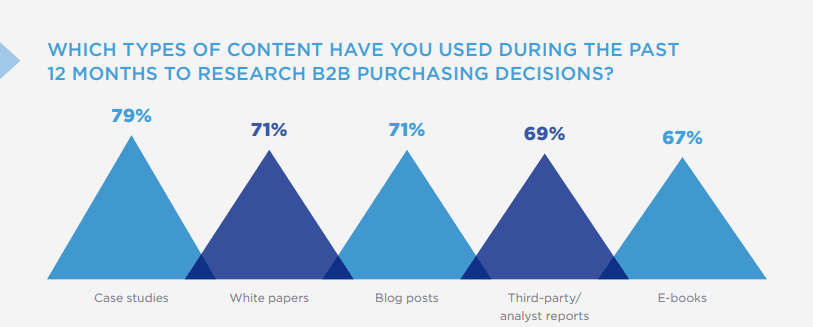 Case studies can fit across the entire buyer’s journey. If your top-of-funnel content attracts problem-aware or solution-unaware visitors, case studies are the bridge to helping them see you as a solution.
There’s an age-old debate in the content community: To gate or not to gate your case studies? There’s an argument to be made for gating them, but the reasons to keep them ungated are more compelling.
Joel Klettke, founder of Case Study Buddy, says that gating case studies is a bad idea because it’s like asking your potential customers to trust you before you’ve earned it. At each stage of the buying process, case studies are key for building trust and arming buyers with information they need to make a decision.
Every situation will be different, but in general, it’s best to keep those case studies as accessible as possible.
Case studies can fit across the entire buyer’s journey. If your top-of-funnel content attracts problem-aware or solution-unaware visitors, case studies are the bridge to helping them see you as a solution.
There’s an age-old debate in the content community: To gate or not to gate your case studies? There’s an argument to be made for gating them, but the reasons to keep them ungated are more compelling.
Joel Klettke, founder of Case Study Buddy, says that gating case studies is a bad idea because it’s like asking your potential customers to trust you before you’ve earned it. At each stage of the buying process, case studies are key for building trust and arming buyers with information they need to make a decision.
Every situation will be different, but in general, it’s best to keep those case studies as accessible as possible.
Tools and templates
Free tools and templates can be a great way to give people a sense of the value you can provide them before actually purchasing from you. Tools and templates that map to high-volume keywords can be a major driver of traffic and leads. Shopify is one of the best in the business when it comes to using free tools to drive links, traffic, and leads.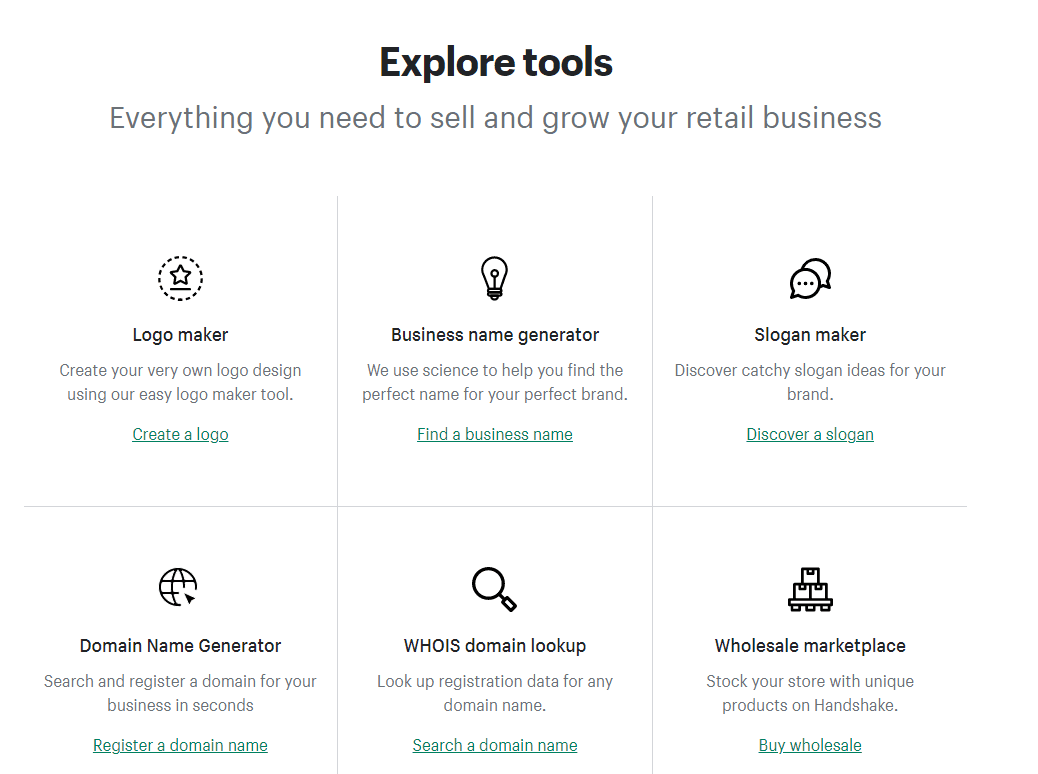 These pages rank highly for high-volume terms. They’re also backlink magnets.
These pages rank highly for high-volume terms. They’re also backlink magnets.
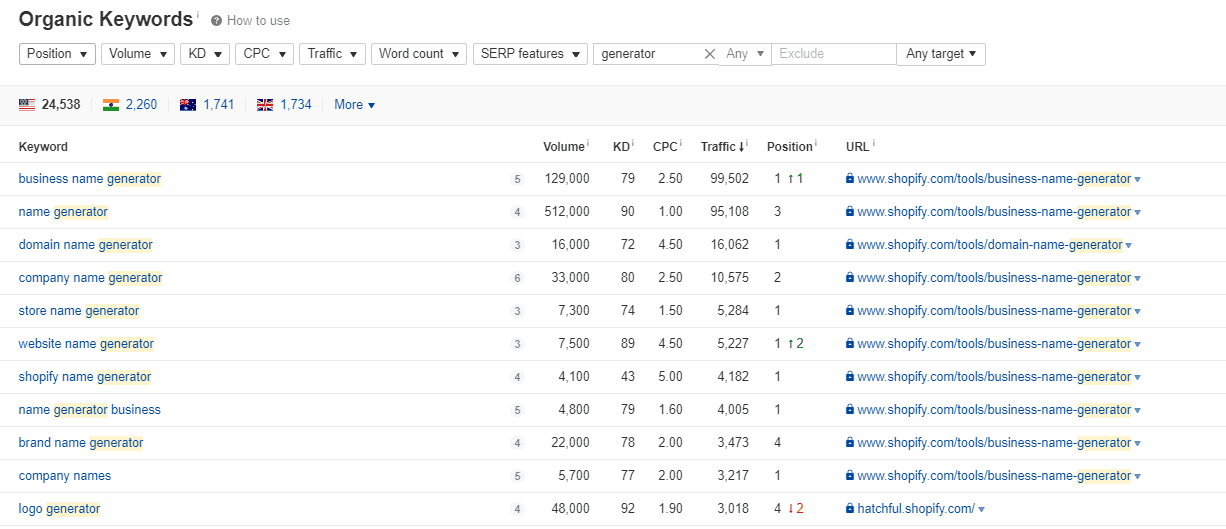 Finding a way to provide a free tool or template with a strong user experience and an optimized page around it could drive similar results for you. These are top of funnel users who could be ideal fits for your paid products if the free ones provide enough value.
Finding a way to provide a free tool or template with a strong user experience and an optimized page around it could drive similar results for you. These are top of funnel users who could be ideal fits for your paid products if the free ones provide enough value.
Post-Purchase Content
One of the most neglected parts of the funnel is post-purchase. This is where you create content for your existing customers. Sometimes as marketers we put so much emphasis on generating demand, turning visitors into leads, and converting them that we forget that our existing customers should also be a focus. In fact, you could make a case that content that helps with customer retention, loyalty, and even evangelism is just as important as anything we produce to attract new business. According to Harvard Business Review, acquiring a new customer can be five to 25 times more expensive than retaining an existing one. Research from Zendesk and Dimensional Research showed that 66 percent of B2B customers stopped buying from a vendor after a poor service experience. Content can play a vital role in driving customer satisfaction and adoption of your products. As VoIP SaaS company Aircall wrote, “Content can be an effective tool to educate, train, and teach customers.” Fittingly, Aircall is a great example of a B2B company with a strong focus on Knowledge Base content for existing users. The knowledge base is loaded with articles that help users complete tasks within the software. One metric you can use to gauge your success with post-purchase content is the number of tickets your success/support teams get from users. As you continue to build your library of post-purchase content, track your teams’ time spent answering basic user questions. It’s all about helping customers help themselves and become power users.Building a Process for B2B Content Strategy
We know why it’s important to have a strategy. We know what kinds of content we can create. Now it’s time to put everything into practice. In this section, we’ll walk through a process that will get you from ideation to creation and distribution. You’ll likely need to tweak this process to fit your own needs and resources, but you’ll come away with a solid baseline to build off of.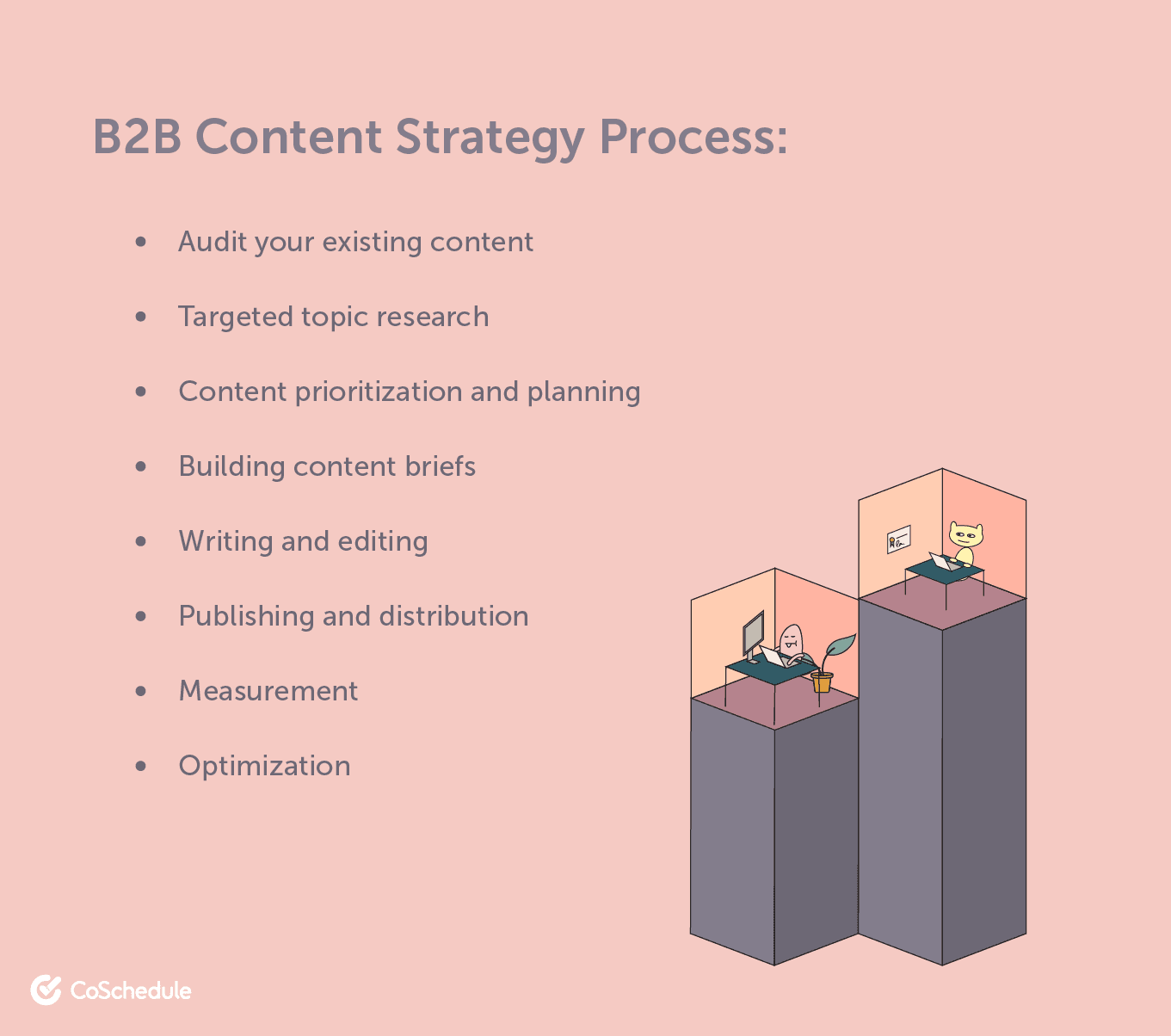
Content Project Management
Whether you have a small or large content team, everything starts with buttoned-up project management. Building a solid process to execute a B2B content marketing strategy will help you execute consistently and drive more predictable results. Content project management can be best achieved with a tool like CoSchedule that will help you keep track of all the moving pieces that come into play as you take content from strategy to execution. Large tasks like “publish a blog post” or “create an eBook” will never get done on time if you leave it at that. Every part of the process needs to be broken down into smaller tasks - topic research, building content briefs, writing, editing, image creation, distribution, etc.Audit Your Content
The best place to start is with what you have. Build a content inventory and audit the content that already exists on your domain. There are a few things you should think about when doing a content audit.- Where you’ve built up topic authority
- The quality of your content
- Content gaps
- Internal and external linking
- What content could be driving better results
- What content is performing well and could be supported with a strong cluster of pages around it.
Topic Research
A successful B2B content strategy will take your business goals and objectives into account and map them to topics you can cover with valuable content. Your strategy should lay out how you’ll attract new users, help them decide which solution is right for them, and then ultimately purchase. Your topic or keyword research will help you map out which specific pieces of content need to be created to serve potential customers no matter where they are in the decision-making process.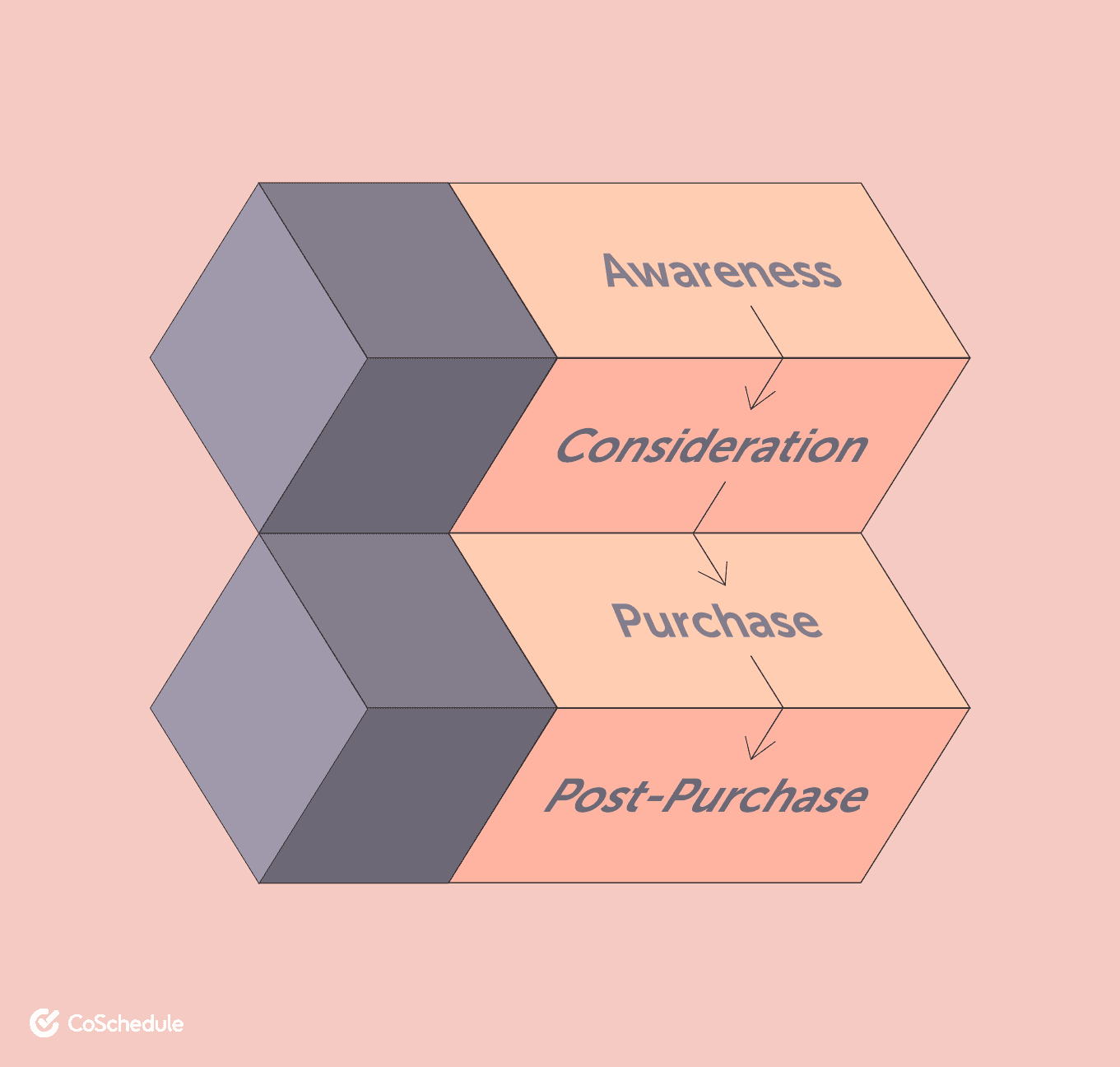 Don’t be fooled - the typical representation of the funnel/buyer’s journey makes it seem like a linear process. It’s anything but that. B2B buyers have to navigate complex processes that include problem identification, exploring solutions, defining requirements, and selecting a vendor.
That’s why you need content that touches on all phases of the funnel. Buyers can enter the funnel at any point, and often skip around. It’s not a linear process. No matter where they are, you need to be able to meet them with valuable content that moves them forward.
Your topic research should start close to your product. What keywords and questions are people using to search for solutions in your category? These are the “money” topics that will be crucial for those final conversions.
For example, if we were creating a content strategy for CoSchedule, we could start with topics like:
Don’t be fooled - the typical representation of the funnel/buyer’s journey makes it seem like a linear process. It’s anything but that. B2B buyers have to navigate complex processes that include problem identification, exploring solutions, defining requirements, and selecting a vendor.
That’s why you need content that touches on all phases of the funnel. Buyers can enter the funnel at any point, and often skip around. It’s not a linear process. No matter where they are, you need to be able to meet them with valuable content that moves them forward.
Your topic research should start close to your product. What keywords and questions are people using to search for solutions in your category? These are the “money” topics that will be crucial for those final conversions.
For example, if we were creating a content strategy for CoSchedule, we could start with topics like:
- CoSchedule vs. Asana/Trello/etc
- CoSchedule alternatives
- Other CoSchedule branded queries
- Marketing project management software
- Editorial calendar software
- Campaign management software
Content Planning and Prioritization
Once you’ve researched your topics, you have to decide which ones you’ll tackle first. Prioritization is a major component of building a successful content strategy, especially if you need to show results in a fairly short amount of time. It’s worth mentioning that content planning is more than just building an editorial calendar. That’s important, but there’s a difference between content planning and true content prioritization. There are a few ways you can think about prioritizing content:- Quick wins
- Long-term goals
- Risk management
Building content briefs
If topic or keyword research answers the question, “What should we write about?” then content briefs answer the question, “How should we write about this topic?” Content briefs are the critical link between strategy and execution. You’re setting yourself up for a lot of frustration and wasted time if you expect a writer - especially if they’re a freelancer - to know exactly how you want to connect a piece of content to your wider content strategy or brand goals. A content brief takes the guesswork out of the writing process. Every team will need something different out of its content briefs, but at a minimum they should include:- The focus keyword or topic
- The user intent of the keyword or topic
- Target audience or buyer personas
- Brand voice, style and tone
- Recommended subheadings that form an outline of the content
- Questions the content should answer
- Related topics that should be covered
- Internal linking suggestions
- External sources that should be linked to
- Related collateral from your organization
Writing and Editing
The content brief should be used as a guideline and foundation for your writers’ expertise. Let them take the brief and synthesize all of the research and source material into something original. Give ample time for content creation. Hitting deadlines is important, but producing quality content that will help a B2B buyer make a decision is the goal. Use some of these content writing tips if you feel like you or your team need some extra help. One of the biggest mistakes writers make is using the top 10 search results on their topic as a template for their own article. This is how you end up with copycat content. Instead, think about how you can use the SEO and editorial guidance in your brief to create something unique and valuable. Here are some ways to do that:- Interview internal and external experts to dive deeper into a topic than what you could get just by searching Google.
- Find ways to write for information gain. What is no one else talking about?
- Collect interesting data from your customers/audience and use it to drive content ideas and original research.
- Borrow content types and ideas from other industries and figure out how to apply them to your situation.
Publishing and Distribution
Just because you have a polished piece, it doesn’t mean the job is done. Getting it over the finish line is a little more involved than it might seem. Publishing a finished article means finalizing headlines, ensuring your internal and external linking is done appropriately, format your content, add images, add calls to action, and Next, it’s time to distribute your content. This is a subject that would be worthy of its own article, but here, we can cover some basic principles. Distribution doesn’t just mean posting links to your content on social media or running a few ads. It means understanding where your audience is and getting your content in front of them in a way that suits the given medium. That could mean condensing your blog post into a Twitter thread, or recording a video that supplements/summarizes an eBook. It could mean taking your podcast audio and using the transcript as fodder for a forum post. This is the part of content marketing that many B2B marketers struggle with. Read this article if you need help building a strong content distribution plan.Measurement
You won’t know if you’re reaching your goals without measuring the results of your content efforts. Here are a few broad categories of goals and how you can measure the success of your content that maps to each one.- Thought leadership and brand visibility: Brand mentions, traffic, video views, followers, press coverage, backlinks.
- Engagement and nurture: Asset downloads, social shares, webinar attendance
- Lead generation: Asset downloads, newsletter opt-ins, demo requests, free trial signups, form fill.
Optimization
Content optimization can mean a lot of things these days. SEO-minded folks might think about optimization in terms of putting keywords in H1s and title tags, or improving the internal link structure around a key page. Content-minded people might think about updating the actual content on the page to be more comprehensive. Both sides are important. A well-written page that has no other pages linking to it will likely be limited in the results it gets, while poor content that is well-optimized from a technical perspective will be similarly restrained. We’ll focus more on the content side of things - we are content strategists after all. When you’re optimizing content, it helps to break your optimization efforts into different buckets:- Pages that were performing well but have plateaued or declined in rankings/traffic.
- Pages that are performing among the best on our site, but could be at risk due to competitive pressure.
- Pages that never performed well.
- The user intent of the topic might change over time, and the content needs to be updated to reflect it.
- New messaging and positioning around your company/product might require you to change how you talk about it within the content.
- A page with thin content needs to have some new sections added to make it more comprehensive.
- A page that’s not getting users to take action or convert might need some optimization around CTA placement.
- A page with generic content might need something to differentiate it.


